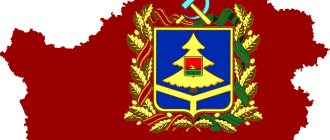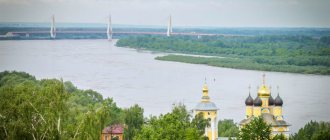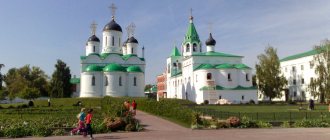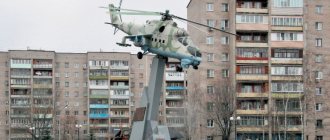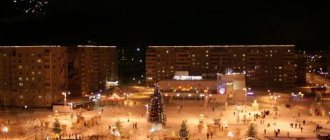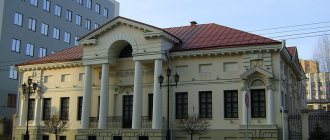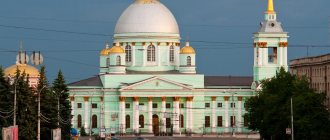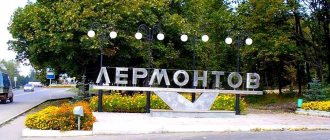For other uses, see Kirzhach (disambiguation).
City in Vladimir region, Russia
| Kirzhach Kirzhach | |
| Town[1] | |
| Panoramic view of Kirzhach | |
| Flag Coat of arms | |
| Location Kirzhach | |
| Kirzhach Location Kirzhach Show map of Russia Kirzhach Kirzhach (Vladimir region) Show map of Vladimir region | |
| Coordinates: 56°09′N 38°52'E / 56.150°N Latitude 38.867°E / 56.150; 38.867Coordinates: 56 ° 09′ N 38°52'E / 56.150°N Latitude 38.867°E / 56.150; 38.867 | |
| A country | Russia |
| Federal subject | Vladimir region[1] |
| Administrative region | Kirzhach district[1] |
| Based | 14th century |
| City status from | 1778 |
| Height | 135 m (443 ft) |
| population (2010 Census)[2] | |
| • General | 29,965 |
| • Evaluate (2018)[3] | 26,676 (−11%) |
| Administrative status | |
| • Capital from | Kirzhach district[4] |
| Municipal status | |
| • Municipal district | Kirzhach municipal district[5] |
| • Urban village | Kirzhach urban settlement[5] |
| • Capital from | Kirzhach municipal district[5], Kirzhach town[5] |
| Timezone | UTC + 3 (MSK [6]) |
| Postal code(s)[7] | 601010 |
| OKTMO I WOULD | 17630101001 |
| Web site | gorodkirzhach.RU |
Kirzhach
(Russian: Kirzhach) is a town and administrative center of Kirzhachsky District in Vladimir Oblast, Russia, located on the Kirzhach River in the west of the region, 125 kilometers (78 mi) west of Vladimir and 29 kilometers (18 mi) south of Aleksandrov. Population: 29,965 (2010 Census).[2]
Story
It was founded in the 14th century as a settlement
assigned to the Annunciation Monastery.[
citation needed
] The latter was established by Saint Sergius of Radonezh, who lived in the area between 1354 and 1358.
For most of its history, the abbey remained largely dependent on the Trinity Lavra of St. Sergius, which lies 48 km to the west. After the dissolution of the monastery in 1764, the settlement
received municipal rights in 1778.[
citation needed
] After this, Kirzhach, like many other cities in the surrounding area, developed primarily as a textile center.
Annunciation Monastery 2011 1781 coat of arms of Kirzhach
On October 12, 2004 in the village of Red October it was merged with the city.
Economy
The leading enterprises of the city are a tool plant, a plant of automotive and tractor lighting fixtures (JSC ""). Light (garment factory), woodworking (furniture factory) and food (canning factory) industries are also developed. The silk factory, founded in 1932 and for a long time the largest enterprise in the city, after privatization in the 1990s, broke up into small enterprises and ceased to exist.
At the beginning of the 21st century, the Turkish company Arcelik built a plant in the city for the production of refrigerators, washing machines and televisions under the Beko brand.
Climate
The climate of the city is temperate continental: warm summers, cold winters with moderate spring and autumn. The average temperature in January is -10.6 °C (12.9 °F) and +18.2 °C (64.8 °F) in July. The average annual precipitation is 584 millimeters (23.0 in). On average, this is 151 days per year with temperatures above 0 °C (32 °F). Snow cover lasts for four to five months; Snow usually starts falling in late November or early December. Snow melts in sunny areas in mid-April and in forests at the end of April.
Etymology of the name
The city received its name from the Kirzhach River. It is part of the so-called series - a cluster of identical geographical names, which also includes the Kirzhelka river, as well as the small stream Kirzhen in the Gaginsky district of the Nizhny Novgorod region. All of them correlate with the Moksha or Erzyan word meaning “left”, which in different dialects has the form kerzhi
,
kerch
or
kersh
. The word "KIRZH" in Old Church Slavonic means "left". Kirzhach stands on the left bank of the river of the same name, the Kirzhach River is a left tributary of the Oka, which, in turn, is a left tributary of the Volga. Previously, the river was navigable for fairly large trading boats (karbas), but then it became very shallow, changed its banks, and was no longer used as a waterway.
The city (more precisely, the settlement) was founded by Sergius of Radonezh during his exodus from the Trinity Monastery in Sergiev Posad. Then, at the great request of the brethren of the Trinity monastery, Sergius of Radonezh returned to Sergiev Posad, leaving his student Roman Kirzhachsky as rector of the monastery he organized. At the end of the 1990s, during excavations in the Annunciation Cathedral of Kirzhach, with the blessing of Patriarch of Moscow and All Rus' Alexy 2, the relics of St. Roman Kirzhachsky.
Architecture and landmarks
Kirzhach is famous for its great monastery - the Annunciation Cathedral. The Catholicon, erected during the reign of Ivan the Terrible, corresponds to the early Moskvich type of cathedral church. It is generally considered one of the last and finest examples of this conservative strain. The monastery has a very interesting structure - it is an open gallery. This gallery connects the cathedral with the nearby Spasskaya Church with a square tower and a tent. Bell tower. This church is the grave of outstanding Russian boyars - the Miloslavskys. The 16th-century church was demolished during the Soviet era, but began to be restored and rebuilt in the 1990s. Today the cathedral is a monastery. Since 1997, the monastery has kept the relics of the Russian saint Roman of Kirzhach, a disciple of another great Russian saint, Sergei of Radonezh. Tourists can see two ancient churches of St. Nicholas - one was built in 1764, the other in 1846. On the facade of the local palace of arts there is a memorial plaque dedicated to the meeting of Yuri Gagarin, the world's first cosmonaut, with local residents on March 29, 1963. On March 27, 1968, 18 km from Kirzhach (near the village of Novoselovo), Gagarin and flight instructor Vladimir Seregin died in a plane crash. A large memorial, museum and visitor area has been built at the crash site. Tourists can also see the buildings of old shopping centers built in the 1850s.
Kirzhach
The city of Kirzhach is the administrative center of the Kirzhach district of the Vladimir region, with a population of 27,157 people (2017). Located on the Kirzhach River (the left tributary of the Klyazma) 125 km west of Vladimir and 90 km northeast of Moscow.
Story
The name of the city comes from the Kirzhach River, which translated from the Mordovian dialects (coming from the Finno-Ugric tribes that inhabited these lands in the first centuries of our era) means “left”. Kirzhach was founded on the left bank of the river of the same name, which is the left tributary of the Klyazma.
Researchers find the first mention of a settlement on the Kirzhach River in the spiritual letter of the Moscow prince Ivan I Kalita, attributing it, according to different versions, to either 1328 or 1332. According to other sources, Kirzhach arose as a settlement founded by Sergius of Radonezh in 1358 Annunciation Monastery. The heyday of the monastery falls on the XV-XVIII centuries. In 1764, as a result of the secularization reform of Catherine II, the Annunciation Monastery was abolished. His churches became parish churches.
The settlement near the former monastery developed, which was facilitated by its favorable location on the Stromynskaya road (it connected Moscow, Yuryev-Polsky, Suzdal, Vladimir). The population of the villages of Kirzhach and Selivanova Gora (on the right bank of the Kirzhach River) was mainly engaged in silk weaving and carpentry. The carpenters were called “arguns”, on behalf of the fishing center - the village of Argunovo, not far from Kirzhach. “Argunov’s decor” on huts and iconostases was known even in Moscow.
In 1778, with the formation of the Vladimir governorship (from 1796 - the Vladimir province), the villages of Kirzhach and Selivanova Gora, which actually represented a single whole based on established economic ties, were united into the county town of Kirzhach. In 1781, the city received its own coat of arms, which reflected its close proximity to the forest: an owl sitting on a stump with outstretched wings is depicted on a green background. At that time there were a lot of owls in the vicinity of the city. The modern coat of arms of Kirzhach, approved in 2009, is a reconstruction of the historical coat of arms of 1781, only the owl and the earth have become gold. It is believed that the image of a wise bird symbolizes the carefree calm, self-control, and unhurried, balanced decision-making that have been characteristic of the Kirzha people for centuries.
Kirzhach enjoyed the right of a district town for only 18 years, and then was turned into a provincial town. The center of the county moved to Pokrov, through which the large Vladimir road was built. The development of Kirzhach with the decline in the importance of Stromynka slowed down. Many of its residents, having lost their income, went to work in Moscow or the Moscow province, to silk factories in Fryanovo and Shchelkovo.
The silence of the provincial town was interrupted by the Patriotic War of 1812. Kirzhach actively participated in the Vladimir militia, forming armed mounted patrols (patrols) on the Stromynskaya road and collecting riflemen. Units of the Vladimir militia selflessly fought fires, typhus and cholera in Moscow abandoned by Napoleon. According to legend, when the surviving militia, exhausted by typhus, returned along Stromynka to their native places in the winter of 1813, they stopped not far from Kirzhach in a pine forest, so as not to expose the townspeople to the risk of infection. This place on the right bank of the river, between Kirzhach and the village of Lisitsyno, is today known as “Lousy Hill” and is protected as a historical monument.
In the first quarter of the 19th century. Industrial development accelerated in Kirzhach. Many former otkhodniks working in Moscow factories began to master silk and velvet production in Kirzhach itself and nearby villages. In the construction of silk weaving and dyeing and finishing manufactories and factories, the leading role was played by merchant-entrepreneurs, father and son, the Solovyovs, and later by their children and grandchildren. In the 19th century The Solovyov dynasty owned a number of silk weaving, yarn-dying, calico-printing, and calico weaving factories, equipped with the latest technology, and also established trading houses. At the same time, working conditions in these industries were very difficult, the working day lasted 12 hours, and child labor was widely used.
However, with the name A.A. Solovyov was associated with almost all charitable undertakings and construction that determined the appearance of the city in the second half of the 19th century: the city Mutual Insurance Society, a women's two-year school, a teachers' seminary, a zemstvo hospital, an almshouse.
Great contribution to the development of the silk weaving industry and the improvement of Kirzhach in the second half of the 19th century. entrepreneurs the Arsentiev brothers, the Derevenshchikov brothers and others also contributed. By 1913, almost 20% of Russian silk fabrics were produced in Kirzhach and surrounding villages.
In the mid-1860s, on the deserted bank of the Kirzhach River (now the village of Red October), the Shaposhnikov copper-brass plant was founded, employing up to four hundred workers.
The plant for the production of copper and brass utensils in 1931 was repurposed into one that produces lighting fixtures for cars and tractors (since 1992 - “Avtosvet”). In 1932, a silk factory was created on the basis of the Solovyov factories, which became one of the largest in the country.
In 1929, Kirzhach became the center of the district as part of the Aleksandrovsky district of the Ivanovo Industrial Region.
During the Great Patriotic War, Kirzhach was one of the strongholds of the all-round defense of the capital, where glider pilots, paratroopers and military pilots were trained. In the city in 1942-1943. the famous women's combat air regiment was based, led by the famous pilot M.M. Raskova, one of the first women to receive the title of Hero of the Soviet Union (1938). The street where the pilots of the air regiment lived during the war is named after her.
After the war, since 1960, the first group of cosmonauts, including Yu.A., was trained at the Kirzhach airfield. Gagarin, G.S. Titov, V.M. Komarov, A.N. Nikolaev, V.F. Bykovsky, P.R. Popovich and others. N.P. was entrusted with training the first cosmonauts. Kamanin, Hero of the Soviet Union, the legendary pilot who led the expedition to rescue the Chelyuskin polar explorers in 1934. The flight test complex of the Scientific Research Institute of Automatic Devices (now the Research Institute of Parachute Engineering) was located in Kirzhach. It was his specialists who created the parachute system for landing the first cosmonaut of the Earth, Yu.A. Gagarin. Several main streets of Kirzhach are named after the astronauts. On the facade of the district house of culture there is a memorial plaque informing about the speech of Yu. Gagarin in front of Kirzha residents in March 1963. On March 27, 1968, Yu.A. tragically died during a training flight near Kirzhach. Gagarin and V.S. Seryogin. A memorial was opened at the site of their death in 1975.
In 1944, Kirzhach became the center of the region as part of the Vladimir region. In 1963, the Kirzhach district was abolished, and in 1965 it was re-formed.
In 2005, the city's borders expanded significantly due to the annexation of the village of Krasny Oktyabr, which became one of the microdistricts of Kirzhach.
Economy
The basis of the modern economy of Kirzhach is the production of machinery and electrical equipment. Once a large manufacturer of auto lighting fixtures, since 2013 it has been repurposed into the Industrial Park, and production has been transferred to Osvar OJSC in Vyazniki and Avtosvet LLC in Dimitrovgrad. The industrial complex of Kirzhach includes the following enterprises: Kirzhach Tool Plant (KIZ), a leading Russian manufacturer of metal-cutting tools; Kirzhach furniture factory, which produces kitchen sets; plywood; the Children's Clothes holding, which included the former Kirzhach Silk Mill, which produces polyester, raincoat, suit and other fabrics; Kirzhach printing house, specializing in the production of diplomas and certificates for universities and schools, etc. Since 2006, a Turkish company has been operating in Kirzhach, producing household appliances (refrigerators and washing machines). In 2006 and 2008, two production lines were launched in the village of Kiprevo, Kirzhach district, producing high-quality ceramic bricks. In October 20014, the production of flexible bitumen tiles was opened in Kirzhach. In the village of Pershino, near Kirzhach, the branch of NPO Nauka produces aerospace products (air conditioning systems, automatic pressure control, life support for aircraft). In the summer of 2013, the Kirzhach aeronautical base, restored after ten years of decline, was presented. Now this is the only airship in Russia, on which Aeronautics (Moscow) tests its largest balloons.
Famous people
The names of many famous people in Russia are associated with Kirzhach. Graduates of the Kirzhach Teachers' Seminary were the greatest Soviet linguist V.I. Chernyshev (1866-1949) and the founder of Soviet petroleum geology, academician I.M. Gubkin (1871-1939). A.M. worked as a seminary teacher for seven years. Lazarev-Gruzinsky (1861-1927), Russian writer, fiction writer, who was friends with A.P. for many years. Chekhov. The pioneer of color photography S.M. was born near Kirzhach (village of Funikova Gora). Prokudin-Gorsky (1863-1944). He created the “Collection of Sights of the Russian Empire S.M. Prokudin-Gorsky. This is one of the world's first collections of color photographs, which represents the diversity of geographical conditions, ethnographic features, architectural monuments, cities, economics, transport - and became a kind of visual encyclopedia of the Russian Empire in the last years of its existence. CM. A special exhibition in the local history museum is dedicated to Prokudin-Gorsky.
Attractions
Kirzhach has a large number of attractions and interesting places for tourists: Annunciation Monastery (XVI-XVII centuries); historical civil buildings of the city of the 19th century, including the mansion of the Vinokurov merchants, which currently houses the Kirzhach regional history and art museum; in the northern part of the city on the Kirzhach River there is “Lousy Hill”, a historical site dedicated to the militias of 1812 and 1941; 18 km from Kirzhach (near the village of Novoselovo) - the place of death of Yu. Gagarin and V. Seregin, where a memorial is now erected; the estate of the Dumnov manufacturers in the village of Zarechye, where a museum complex dedicated to the history of hand-made silk weaving is located, as well as an exhibition of author’s ethnographic dolls by Galina Maslennikova. In the summer of 2016, another attraction appeared in Kirzhach - the Typographic Bridge, the longest wooden pedestrian bridge in Russia (555 m), built for the 85th anniversary of the Kirzhach Printing House and included in the large-scale project “Kirzhach Tourist”. It connected the new “Alexandrovsky Garden” with a children’s playground and a concert venue, on the “typographical” side of the bridge, with the city center.
For those who love various types of active tourism, the country club "Polan" (village of Ivashevo) offers an indoor horse riding arena for dressage and riding lessons. The aviation sports and technical club "Strizh" at the Slobodka airfield near Kirzhach organizes parachute jumps.
Author: V. Korolkova
Recommendations
Notes
- ^ a b c d
Resolution #433 - ^ a b c
Federal State Statistics Service of Russia (2011).
“All-Russian Population Census 2010. Volume 1" [All-Russian Population Census 2010, vol. 1]. All-Russian Population Census 2010 [All-Russian Population Census 2010]
(in Russian). Federal State Statistics Service. - "26. The size of the permanent population of the Russian Federation by municipalities as of January 1, 2022.” Federal State Statistics Service. Retrieved January 23, 2022.
- ^ a b
State Committee of the Russian Federation on Statistics.
Committee of the Russian Federation for Standardization, Metrology and Certification. No. OK 019-95 January 1, 1997 “All-Russian classifier of objects of administrative-territorial division. Code 17 230”, Ed. changes No. 278 / 2015 dated January 1, 2016. (State Committee of the Russian Federation on Statistics. Committee of the Russian Federation on Standardization, Metrology and Certification. No. OK 019-95 January 1, 1997 Russian Classification of Administrative Objects (OKATO). Code 17 230
As amended by Amendment No. 278/2015 dated January 1, 2016). - ^ a b c d f
Law No. 36-OZ - "On the calculation of time." Official Internet portal of legal information
(in Russian). June 3, 2011. Retrieved January 19, 2022. - Post office. Information and computing center of OASU RPO. ( Post office
).
Search for postal facilities ( Search for postal facilities
) (in Russian) - “All-Union Population Census of 1989. The actual population of union and autonomous republics, autonomous regions and districts, territories, regions, urban settlements and villages Vladimirskie Vedomosti”, No. 114, June 20, 2007 (Administration of the Vladimir Region. Resolution No. 433 dated June 13, 2007 On the register of administrative-territorial formations and units of the Vladimir region
As amended by Resolution No. 169 of March 5, 2015
On amendments to the Decree of the Regional Governor dated June 13, 2007 No. 433 “On the register of administrative-territorial formations and units Vladimir region".
Valid from the date of official publication.). - Legislative Assembly of the Vladimir Region. Law No. 36-OZ of April 27, 2005 “On granting the Kirzhach district and newly formed municipalities included in its official status as municipalities and establishing their boundaries,” as amended. Law No. 113-OZ of August 10, 2009 “On amendments to the Law of the Vladimir Region” On granting the Kirzhach district and newly formed municipalities included in its composition the status of municipalities and establishing their boundaries “”. Came into force on the date of official publication (April 29, 2005). Published: “Vladimirskie Vedomosti”, No. 140, April 29, 2005 (Legislative Assembly of the Vladimir Region. Law No. 36-OZ of April 27, 2005 On giving the Kirzhach district and its constituent municipalities the corresponding status of municipalities and establishing them borders
As amended by Law No. 113-OZ of August 10, 2009.
On amendments to the Law of the Vladimir Region “On giving the Kirzhach district and its newly created municipalities the corresponding status of municipalities and on establishing their boundaries
.” Valid from the date official publication (April 29, 2005).
Population
The significant growth in the population of Kirzhach is associated with the construction of new and expansion of existing factories and plants. In the 1990s, the population decreased. An abrupt increase in numbers occurred when new territories were included in the city, including the village of Krasny Oktyabr.
| Change in the population of Kirzhach | |||||||||||||
| Year | 1862 | 1897 | 1914 | 1915 | 1916 | 1939 | 1959 | 1970 | 1979 | 1989 | 2002 | 2009 | 2010 |
| Population (persons) | 2 737 | 4 800 | 7 164 | 4 232 | 4 446 | 11 600 | 18 100 | 21 561 | 24 122 | 25 400 | 22 704 | 30 100 | 29 639 |
Social sphere
8.1. Education
The industrial orientation of Kirzhach determined the high level of literacy of its population. In 1897, in Kirzhach there were 60% literate men and 36% literate women. In pre-revolutionary times, in 1915, in Kirzhach there were the following educational institutions: a private gymnasium, a teachers' seminary, a higher primary school, a vocational school, etc. In 1921, the district ranked first in literacy in the province[4].
Currently in the city there are:
- 6 secondary schools, one evening school, 13 kindergartens, State educational institution of secondary vocational education “Kirzhach Machine-Building College” (Krasny Oktyabr microdistrict, Pushkina St., 29) Regional state educational institution of primary vocational education “Vocational School No. 55” (Michurina st., 4)
8.2. Institutions of additional education
- Center for Children's Creativity (Naberezhnaya St., 9. Director). Children's health and educational sports center (Gagarina St., 46, Kommunalnaya St., 3. Director). Center for additional education for children “Rovesnik” (Krasny Oktyabr microdistrict, Oktyabrskaya st., 14. Director).
The children's sports school is famous for its high sports achievements, which annually trains young athletes, skiers, and chess players. In 1996, a student of this school, training under the guidance of teacher Yu. A. Golub, Volodya Belov became the champion of Russia for young chess players and was invited to participate in competitions for young chess players for the title of world champion[5].
8.3. Cultural institutions
- Regional History, Local Lore and Art Museum (Gagarina St., 52). House of Folk Art (Ostrovsky St., 32). Regional Center of Folk Culture (Gagarina St., 37). District House of Culture (Gagarina St., 22). Children's art school (Krasny Oktyabr microdistrict, Pervomaiskaya st., 6a). Kirzhach Children's Art School (Seryogina St., 10). Municipal cultural institution "Centralized Library System" of the Kirzhach district (17 branches) Address of the Central Library st. Seregina, 10
8.4. Medical institutions
The first hospital in Kirzhach was built as a zemstvo hospital in 1878, mainly at the expense of the richest silk manufacturer A. A. Solovyov. In the historical and statistical description of the city, published then, it is called magnificent and luxurious. The complex of wooden buildings served for more than 100 years and partially survive to this day[5].
- MMU "Krasnooktyabrskaya district hospital" (microdistrict Krasny Oktyabr, Pushkin St., 1. Chief doctor). MUZ "City Clinic No. 1" (Dzerzhinsky St., 1. Chief doctor). MMU "Kirzhach Central District Hospital" (Bolnichny proezd, 11. Chief doctor).
